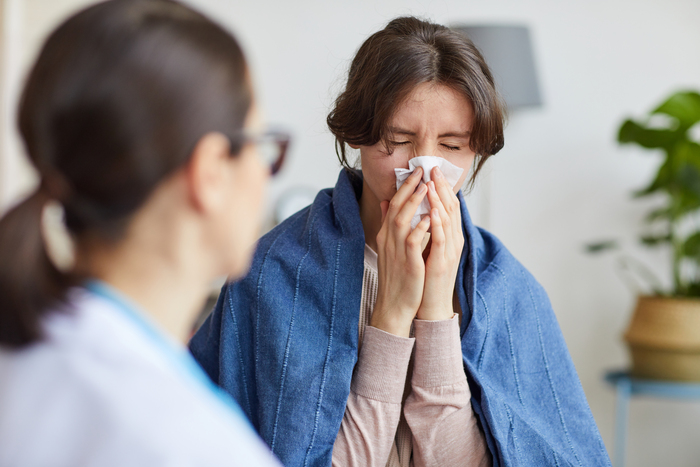Key points
- The flu's incubation period, the time between exposure to the virus and onset of symptoms, typically lasts two to four days.
- Individuals can spread the flu about 24 hours before symptoms appear and remain contagious for up to seven days.
- The flu primarily spreads through respiratory droplets and fomite transmission, emphasizing the importance of hygiene and disinfection.
- Managing flu symptoms can include antiviral medications, rest, hydration, over-the-counter medications, good hygiene, and seeking professional care if symptoms don't improve.

Influenza, commonly known as the flu, is a viral infection that can lead to significant health complications, especially in vulnerable populations. The incubation period refers to the time between exposure to the virus and the onset of symptoms, while contagiousness indicates when an infected person can spread the virus to others. Understanding the flu's incubation period and contagiousness is crucial for effective prevention and control measures, according to the National Foundation for Infectious Diseases.
What is the flu incubation period?
The flu incubation period is the time it takes for symptoms to appear after being exposed to the influenza virus. On average, this period lasts from two to four days, but it can vary based on several factors, according to the CDC. They explain that individual immune responses play a significant role; a person with a stronger immune system may take longer to show symptoms, while someone with a weakened immune system might exhibit symptoms sooner. Additionally, the amount of virus a person has been exposed to can influence the incubation period. For instance, a higher viral load may lead to quicker onset of symptoms. Other factors, such as age, overall health, and even the specific strain of the influenza virus, can also contribute to variations in the incubation period.
How long is the flu contagious?
The flu is typically contagious starting about 24 hours before symptoms appear, according to the CDC — meaning individuals can spread the virus even when they feel perfectly healthy. Once symptoms begin, the contagious period usually lasts up to seven days. However, it's important to note that this timeframe can be extended in children, who often have weaker immune systems and may shed the virus for a longer duration. This extended contagiousness in children underscores the importance of vigilant hygiene practices and prompt isolation when flu symptoms arise to help mitigate the spread of the virus.
How does the flu spread?
The flu primarily spreads through two mechanisms: respiratory droplets and fomite transmission. The CDC advises that understanding these methods is essential for implementing effective prevention strategies to reduce the risk of infection.
-
Respiratory Droplets: The most common way the flu spreads is through respiratory droplets that are expelled when an infected person coughs, sneezes, or talks. These droplets can travel short distances—typically up to six feet—and can be inhaled by people nearby. If a person breathes in these droplets, they can become infected with the virus. This mode of transmission is particularly concerning in crowded or enclosed spaces where close contact occurs, making it easy for the virus to spread rapidly among individuals.
-
Fomite Transmission: In addition to respiratory droplets, the flu can also spread through fomite transmission. This occurs when the virus lands on surfaces or objects—such as doorknobs, light switches, or shared electronics—that are then touched by another person. If that person subsequently touches their face, particularly their mouth, nose, or eyes, they can introduce the virus into their body and become infected. Fomite transmission highlights the importance of regular handwashing and disinfecting commonly touched surfaces to help prevent the spread of the flu virus.
Does a flu shot work?
Getting the annual flu shot can significantly lower your chances of becoming sick or experiencing severe symptoms if you do become sick, according to the CDC. The vaccination helps by stimulating your immune system to produce antibodies that target and fight the influenza virus. According to research published by the National Library of Medicine, these antibodies reduce the likelihood of infection and can also lessen the severity of symptoms if you do contract the flu.
Annual flu shots are formulated to protect against the most common or anticipated flu strains for the season, ensuring effective coverage. By reducing the overall number of flu cases, flu vaccinations also help lower the risk of widespread outbreaks, protecting not only individuals but also vulnerable populations, such as young children, the elderly, and those with compromised immune systems.
6 tips to follow if you have the flu
Dealing with the flu can be challenging, as it often brings a range of uncomfortable symptoms that can disrupt daily life. However, there are several strategies you can implement to help manage your illness and promote recovery. By following these tips from the CDC, you can alleviate your symptoms and reduce the risk of spreading the virus to others:
-
Take a Flu Antiviral: If prescribed by a healthcare professional, antiviral medications can help reduce the severity and duration of flu symptoms. It’s most effective when taken within the first 48 hours of symptom onset.
-
Get Plenty of Rest: Your body needs extra energy to fight off the virus, so prioritize rest and sleep. Allowing yourself to recuperate will help speed up the healing process.
-
Stay Hydrated: Drink plenty of fluids, such as water, herbal teas, and broths. Staying hydrated is crucial for maintaining overall health and can help alleviate symptoms like fever and congestion.
-
Manage Symptoms: Over-the-counter medications can help relieve symptoms such as fever, aches, and cough. Be sure to follow the recommended dosages and consult with a healthcare professional if you have any concerns.
-
Practice Good Hygiene: To prevent spreading the virus to others, cover your mouth and nose when coughing or sneezing, wash your hands frequently, and avoid close contact with others.
-
Seek Professional Care if Symptoms Don’t Improve: If your symptoms worsen or do not start to improve after a few days, it’s important to consult a healthcare provider. They can assess your condition and recommend appropriate treatment options.
Urgent care near me
If you're feeling under the weather and need immediate medical attention, use Solv to find a top-rated urgent care facility near you.
FAQs
What is the incubation period for the flu?
The incubation period for the flu is the time it takes for symptoms to appear after being exposed to the influenza virus. This period typically lasts from two to four days, but can vary based on factors such as individual immune responses, the amount of virus exposure, age, overall health, and the specific strain of the influenza virus.
When is a person with the flu contagious?
A person with the flu is typically contagious starting about 24 hours before symptoms appear and remains contagious for up to seven days after symptoms begin. However, this timeframe can be extended in children, who often have weaker immune systems and may shed the virus for a longer duration.
How does the flu spread?
The flu primarily spreads through respiratory droplets expelled when an infected person coughs, sneezes, or talks, and through fomite transmission, which occurs when the virus lands on surfaces or objects that are then touched by another person.
How can I prevent getting the flu?
Getting the annual flu shot can significantly lower your chances of becoming sick. Regular handwashing and disinfecting commonly touched surfaces can also help prevent the spread of the flu virus.
What should I do if I have the flu?
If you have the flu, take antiviral medications if prescribed by a healthcare professional, get plenty of rest, stay hydrated, manage symptoms with over-the-counter medications, practice good hygiene to prevent spreading the virus, and seek professional care if symptoms don’t improve.









